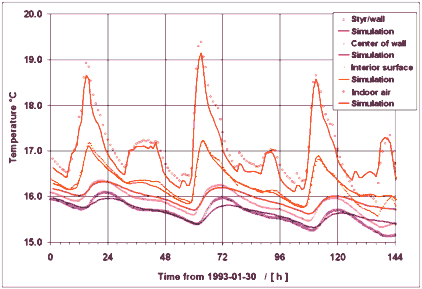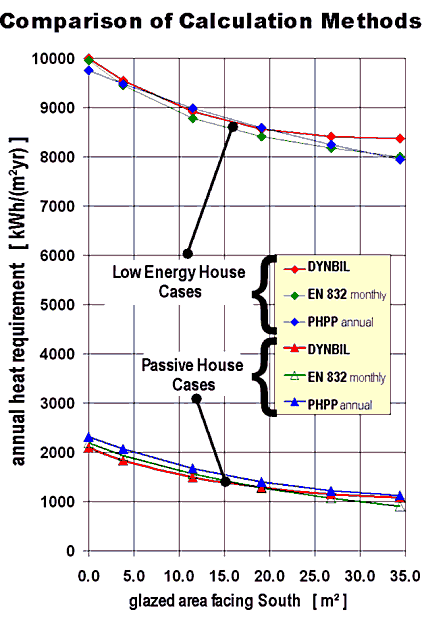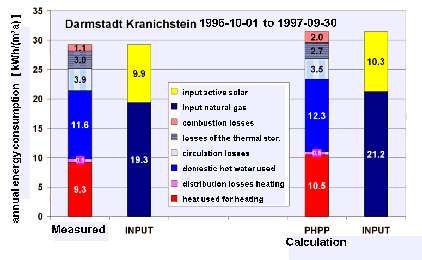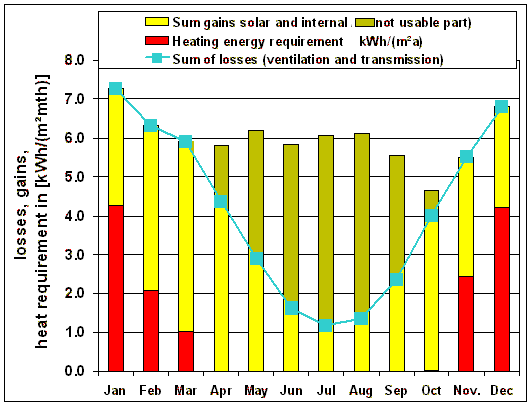| |
PHPP:
Far More Than Just An Energy Calculation Tool |
|
|
Fig.1: The Passive House Planning (Design) Package PHPP consists of a calculation workbook and a handbook - it is an important tool to design Passive Houses.. Fig. 2:
Comparison of Measurement and Simulation for data collected
in the scientific research project "Passive
House Passivhaus Darmstadt Kranichstein". (Click on the
diagram to show higher resolution. The simulation program used was
DYNBIL; the comparison was published in [AkkP 5]).
Fig. 4: Comparison of Measured Consumption Data (Statistical Data) with PHPP-calculation results. It is important to compare the average values from a sufficiently large sample, as the individual consumption values will vary a great deal due to differences in user behavior. The average values compare very favorably with the PHPP-results (Click on the diagram to show a higher resolution). Fig. 5 This balance (right side) was calculated by PHPP; it is corresponding to the very first Passive Houses realized in Darmstadt Kranichstein (Architects: Prof. Bott, Ridder, Westermeyer). The results of the monitoring program (left side) compare quite well to the calculated balance. The measurement was done using calibrated heat flow meters and natural gas meters. (Right click and "Open image" in your browser to show the diagram in higher resolution.) The good
compatibility of the calculation and the measurement results are
not just by chance in the projects documented here. Experiences
with some 1000 projects designed with the aid of PHPP are excellent.
|
| The Passive House Planning (Design) Package (PHPP) includes:
The Scientific Background: Simulation Program Solidly Rooted In Principal Equations of Physics For the first Passive Houses, it was indispensable to use sophisticated modeling, employing many sets of high-resolution dynamic data. Calculating the energy balance of buildings with very low energy consumption is a demanding task - existing codes and standards proved too inaccurate (in that, little has changed to this day). The challenge: the input data for an intermittent simulator routine are very extensive – our computer model for Darmstadt Kranichstein requires over 2000 independent input data (without the climatic data set). If the simulation is to provide reliable results, these data must be in accordance with the actual geometry of the building. This is indeed possible, as we can see from the comparison between simulations and plotted actual measurement data ([AkkP5] Fig. 2, above left). The expenditure for such a model is extensive, and not all the necessary data are of equivalent importance. Nevertheless, we have identified in the meantime the critical factors for preparing reliable calculations - with tools that are simple to use and with acceptable effort in terms of data input. The technique for designing well-performing passive houses has now been tried, tested and optimized in thousands of cases. A Pragmatic Solution: Simplified Model, Well Defined Input Data In comparing different simulation models and tools, we were able to distill which elements are truly important. In this way it was possible to devise simplified models to be used with an affordable effort and which still provide reliable results [Feist, 1994]. The development of the simplifications is published [AkkP 13]. It may be surprising, but accuracy sufficient for practical planning purposes can be achieved using a quite simple model. That is:
(see fig.
3 in the column left hand side).
To briefly discuss this last point: Most highly developed simulation programs are very accurate with respect to certain of the physical processes (e.g. non-stationary thermal transmission or for radiant heat transfer), but these models serve to distort in other areas (e.g. angle-dependent radiation transmission through glazing; the shading of solar radiation by balconies, lintels, etc). So far, no single program has been able to fully address all relevant processes to the exacting satisfaction of physics. Even at future such a program would be highly complex, which will create additional potential for errors. Naturally, any such simplification implies a lost in accuracy - but each datum that is not fully correct when put into a complex model will also lead to losses of accuracy. And, pragmatically viewed, the computational accuracy possible is, at any rate, limited by the precedent case of data not predictable with high accuracy – the weather! We do not argue here expressly against the use of detailed simulation programs: On the contrary, these programs are the only acceptable way for scientific research. But for the practical purpose of building design, employing already well-tested building concepts, the use of simplified, optimally adapted computing tools will reduce the probability of errors and might therefore be even more accurate. The tool optimally adapted for the design of Passive Houses is the well-proven PHPP (Passive House Planning Package). The PHPP has been calibrated with simulation calculations using complex dynamic models. Why is PHPP more accurate for energy efficient buildings than other tools? PHPP was systematically developed by aligning the utilization rate function with the results of dynamic simulation models [AkkP 13]. For this development only such models were used as had been validated against monitoring results of built passive houses (see fig. 2 in the left column). By this method was the standard for Passive Houses aligned, as well as a standard for buildings with low, but not as low, energy requirement for heating. However, for such buildings the calculation differs slightly from what is given in the European standard EN 832 (ISO 13 790). But the difference is not important for conventional buildings - it is only of influence for buildings with very long time constants. In this class of buildings the ISO 13 790 tourns out to be a little bit too optimistic. The results from PHPP-calculation have been repeatedly compared with monitoring results of sufficiently large samples of built Passive Houses (see fig. 4 on the left side). These comparisons have always shown a very good correlation. The PHPP clearly uses boundary conditions that are significantly different from the calculation process used for the German Energy Conservation Ordinance (EnEV). There are important reasons for this - these are discussed in detail in [Feist 2001] and given in short here:
These and additional
topics result in differences in calculation results, which are significant
for energy efficient buildings. More than just an Energy Calculator The PHPP was not primarily developed just to calculate energy requirement verifications. Much more, the PHPP is a design-tool, which can be used by the architect and the engineers to design and optimize their Passive House project. In the PHPP they will find dimensioning tools for the windows (with attention to optimal comfort), for the heat recovery ventilation system (with attention to good indoor air quality and sufficient relative humidity), for the mechanical systems and for summer comfort. Within PHPP, the building and the mechanical equipment are treated as one overall system. The PHPP-handbook is not restricted to explaining the use of the spreadsheets and the compilation of the input data. Rather, the handbook gives advice on how to optimize the design (e.g. how to build very air-tight, how to avoid thermal bridges, how to minimize construction costs). All this is very useful during the planning phase and for quality control work as well. This link leads to the main site of the Introduction to Passive Houses.
[AkkP 5] Energiebilanz
und Temperaturverhalten; Protokollband Nr. 5 des Arbeitskreises
kostengünstige Passivhäuser, 1. Auflage, Passivhaus Institut,
Darmstadt 1997 GERMAN (Link
zur Publikationsliste, [AkkP 13] Energiebilanzen
mit dem Passivhaus Projektierungs Paket; Protokollband
Nr. 13 des Arbeitskreises kostengünstige Passivhäuser,
1. Auflage, Passivhaus Institut, Darmstadt 1998 GERMAN (Link
zur Publikationsliste, [AkkP 20] Passivhaus-Versorgungstechnik;
Protokollband Nr. 20 des Arbeitskreises kostengünstige Passivhäuser,
1. Auflage, Passivhaus Institut, Darmstadt 2000 GERMAN (Link
zur Publikationsliste, [Feist 2001]
Stellungnahme
zur Vornorm DIN-V-4108-6:2000 [PHPP 2004] Feist, W.;
Pfluger, R.; Kaufmann, B.; Schnieders, J.; Kah, O.: Passive
House Planning Package 2004/2007, Passive House Institute
Darmstadt, 2004/2007 (Link: PHPP-contend).
(updated: 2007-05-26
Author: Wolfgang Feist; |








 Read
more about the coming
Read
more about the coming 

